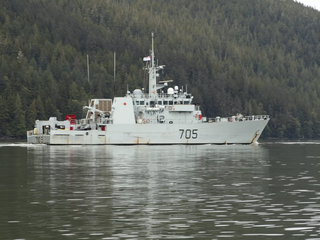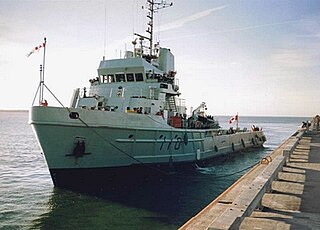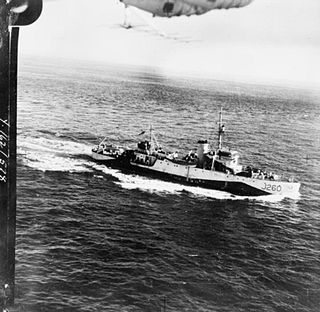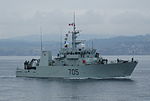
HMCS Glace Bay is a Kingston-class coastal defence vessel that has served in the Canadian Forces and Royal Canadian Navy since 1996. Glace Bay is the second ship of her class which is the name for the Maritime Coastal Defence Vessel Project. She is the second vessel to use the designation HMCS Glace Bay. She is assigned to Maritime Forces Atlantic (MARLANT) and is homeported at CFB Halifax.

HMCS Goose Bay is a Kingston-class coastal defence vessel that has served in the Canadian Forces since 1998. Goose Bay is the eighth ship of her class which is the name for the Maritime Coastal Defence Vessel Project. She is the first vessel to be named Goose Bay. The coastal defence vessel is assigned to Maritime Forces Atlantic (MARLANT) and is homeported at CFB Halifax.

HMCS Brandon is a Kingston-class coastal defence vessel that has served in the Canadian Forces since 1999. Brandon is the eleventh ship of her class. She is the second vessel to use the name HMCS Brandon. The Brandon is assigned to Maritime Forces Pacific (MARPAC) and is homeported at CFB Esquimalt.

HMCS Edmonton is a Kingston-class coastal defence vessel that has served in the Canadian Forces since 1997. Edmonton is the fourth ship of its class, all of which were built for the Maritime Coastal Defence Vessel Project. The ship is the first vessel to use the designation HMCS Edmonton. The ship is assigned to Maritime Forces Pacific (MARPAC) and is homeported at CFB Esquimalt.

HMCS Kingston is a Kingston-class coastal defence vessel that has served in the Canadian Forces since 1996. Kingston is the lead ship of her class, ordered under the Maritime Coastal Defence Vessel Project. She is the first vessel to use the designation HMCS Kingston. She is assigned to Maritime Forces Atlantic (MARLANT) and is homeported at CFB Halifax.

HMCS Moncton is a Kingston-class coastal defence vessel that has served in the Canadian Forces since 1998. Moncton is the ninth ship of her class. She is the second vessel to use the designation HMCS Moncton. The ship is assigned to Maritime Forces Atlantic (MARLANT) and is homeported at CFB Halifax.

HMCS Nanaimo is a Kingston-class coastal defence vessel that has served in the Canadian Forces and Royal Canadian Navy since 1997. Nanaimo is the third ship of her class. She is the second vessel to use the designation HMCS Nanaimo. She is assigned to Joint Task Force Pacific and is homeported at CFB Esquimalt.

HMCS Saskatoon is a Kingston-class coastal defence vessel delivered to the Canadian Forces in 1998. Saskatoon is the tenth ship of her class and is the second vessel to use the designation HMCS Saskatoon. Named after the Canadian city of Saskatoon, Saskatchewan, other references to the city are found on the ship with the ships captains desk named Cranberry Flats and a main corridor in the ship named after Idylwyld Drive. Saskatoon is assigned to Maritime Forces Pacific (MARPAC) of the Royal Canadian Navy and is homeported at Canadian Forces Base (CFB) Esquimalt.

HMCS Shawinigan is a Kingston-class coastal defence vessel that has served in the Canadian Forces and the Royal Canadian Navy since 1997. Shawinigan is the fifth ship of her class. She is the second vessel to use the designation HMCS Shawinigan. The ship is assigned to Maritime Forces Atlantic (MARLANT) and is homeported at CFB Halifax.

HMCS Summerside is a Kingston-class coastal defence vessel of the Royal Canadian Navy that has served in the Canadian Forces since 1999. Summerside is the twelfth, and last, ship of her class. She is the second vessel to use the designation HMCS Summerside. She is assigned to Maritime Forces Atlantic (MARLANT) and is homeported at CFB Halifax.

HMCS Whitehorse is a Kingston-class coastal defence vessel that has served in the Canadian Forces since 1998. Whitehorse is the sixth ship of her class. The first vessel named for the city in the Yukon, the ship is assigned to Maritime Forces Pacific (MARPAC) and is homeported at CFB Esquimalt.

HMCS Yellowknife is a Kingston-class coastal defence vessel that has served in the Canadian Forces since 1998. Yellowknife is the seventh ship of her class. She is the first vessel to use the designation Yellowknife in the Royal Canadian Navy. The coastal defence vessel is assigned to Maritime Forces Pacific (MARPAC) and is homeported at CFB Esquimalt.
HMCS Chaleur was a Bay-class minesweeper that served in the Royal Canadian Navy for three and a half months in 1954 before being sold to the French Navy to become La Dieppoise. The ship was named for Chaleur Bay, located between Quebec and New Brunswick. Her name was given to her replacement, Chaleur (MCB 164). As La Dieppoise, the vessel served as a coastal patrol vessel in the France's Pacific Ocean territories. The ship was taken out of service in 1987.

The Anticosti-class minesweepers were a class of minesweepers that served with the Canadian Forces from 1989–2000. The class consisted of two former oil rig supply vessels, Jean Tide and Joyce Tide. They were acquired by Maritime Command (MARCOM) and commissioned in May 1989 with Jean Tide becoming HMCS Anticosti (MSA 110) and Joyce Tide becoming HMCS Moresby (MSA 112). Once the Kingston-class coastal defence vessels became operational, the Anticosti class was discarded and the two ships returned to mercantile use.

HMCS Anticosti was an Anticosti-class minesweeper that served in the Canadian Forces from 1989 to 2000. Originally an oil rig support vessel, she was purchased in 1989 and saw service until the entry of the newer Kingston-class coastal defence vessels. The ship was named for Anticosti Island, the second to bear the name. Following her Canadian naval career, Anticosti was sold to commercial interests.

The Maritime Coastal Defence Vessel Project (MCDVP) was a procurement project undertaken by the Department of National Defence beginning in the mid-1980s to find a replacement to fill the minesweeper, coastal patrol and reserve training needs of the Canadian Forces, replacing the Anticosti and Bay-class minesweepers, Porte-class gate vessels and Royal Canadian Mounted Police coastal launches in those roles. After construction these vessels became known as the Royal Canadian Navy's Kingston-class maritime coastal defence vessels (MCDVs).
HMCS Moresby was an Anticosti-class minesweeper that served in the Canadian Forces from 1989 to 2000. She was named for Moresby Island, which in turn is named for Fairfax Moresby, former Commander-in-Chief of Pacific Station at Esquimalt Royal Navy Dockyard. Prior to her acquisition by Canada, Moresby served as the offshore supply vessel Joyce Tide, built by Allied Shipbuilders of Vancouver, British Columbia. Joyce Tide was acquired by the Canadian Forces for conversion to a minesweeper and as a training ship for naval reservists. With the entry into service of the Kingston-class coastal defence vessels, Moresby was sold to commercial interests, returning to her previous career. The ship was renamed several times, most recently Ramco Express in 2007.

HMCS Goderich was a Bangor-class minesweeper constructed for the Royal Canadian Navy during the Second World War. Entering service in 1941, Goderich spent the entire war as a local convoy escort based out of Halifax, Nova Scotia. The vessel was decommissioned in 1945 and placed in reserve. Reacquired during the Korean War, the vessel was modernized but never re-entered service and was sold for scrap and broken up in 1959.
HMCS Fort William was a Bangor-class minesweeper that served with the Royal Canadian Navy during the Second World War. Entering service in 1942, the minesweeper participated in the Battle of the Atlantic as a convoy escort and in the invasion of Normandy. Following the war, the ship was laid up, but was reacquired during the Korean War. Fort William never re-entered service with the Royal Canadian Navy and in 1957, was sold to Turkey. Renamed Bodrum by the Turkish Navy, the ship was discarded in 1971.
HMCS Westmount was a Bangor-class minesweeper that served with the Royal Canadian Navy during the Second World War. Entering service in 1942, the minesweeper spent the entire war on the Atlantic Canada coast. Following the war, the ship was laid up in reserve until reacquired in 1952 during the Korean War. Never re-entering service with the Royal Canadian Navy, the vessel was sold to the Turkish Navy in 1958. Renamed Bornova, the minesweeper was discarded in 1972.



























